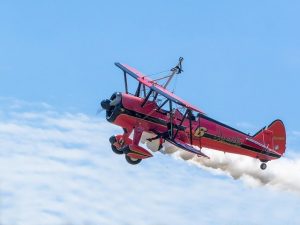 Wings are an essential component of all airplanes. Whether it’s a small private airplane or a jumbo-sized commercial airplane, they need wings to generate lift. There are differences in air pressure between the top and bottom of an airplane’s wings. With greater air pressure below the airplane’s wings, lift is generated. The wings produce lift that allows airplanes to seemingly float in the air. While all wings produce lift, though, they don’t all feature the same configuration. Below are some of the most common wing configurations used in airplanes.
Wings are an essential component of all airplanes. Whether it’s a small private airplane or a jumbo-sized commercial airplane, they need wings to generate lift. There are differences in air pressure between the top and bottom of an airplane’s wings. With greater air pressure below the airplane’s wings, lift is generated. The wings produce lift that allows airplanes to seemingly float in the air. While all wings produce lift, though, they don’t all feature the same configuration. Below are some of the most common wing configurations used in airplanes.
Monoplane
The most common wing configuration used in airplanes is monoplane. Monoplane refers to a single wing that extends horizontally across an airplane’s body. There are several subtypes of monoplane wings, some of which include low monoplane, mid-wing monoplane, shoulder-wing monoplane and high-wing monoplane. These subtypes simply refer to the height at which the wing is installed relative to the airplane’s body. Regardless, the monoplane configuration consists of a single long wing that runs horizontally across an airplane’s body.
Biplane
While not as common as monoplane, some airplanes use a biplane wing configuration. Biplane refers to the use of two wings or more wings. As shown in the photo above, the biplane configuration typically consists of two wings, with one wing located over the other wing. With that said, biplane wings can have three or more wings. Biplane wings have been around for well over a century. Up until the 1930s, in fact, biplane was the most common wing configuration used in airplanes. The monoplane configuration has since surpassed the biplane configuration, with most manufacturing and pilots preferring it.
Staggered
Another wing configured used in airplanes is staggered. What is a staggered wing configuration exactly? Staggered wings consist of two wings in different positions. The top wing is positioned in front of the lower wing. Some airplanes use staggered wings to generate more lift. With a staggered configuration, the wings produce additional lift. The difference is nominal, however, which is why staggered wings aren’t used by many airplanes.
Tandem
Finally, tandem wing configuration refers to the use of two wings. One of the wings is located forward, whereas the other wing is located in the rear. Both wings in a tandem configuration produce lift. Tandem wings differ from other multi-winged configurations by isolating their two wings. Each wing in a tandem configuration is separated from the other wing. Therefore, both wings produce lift.



